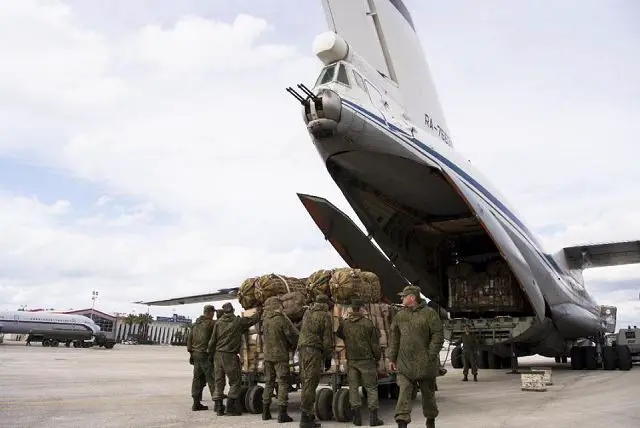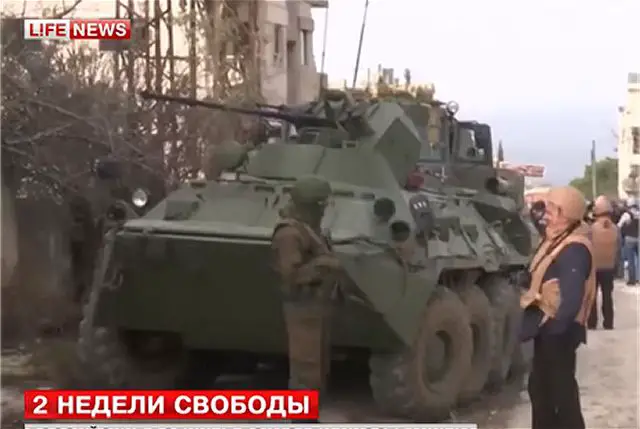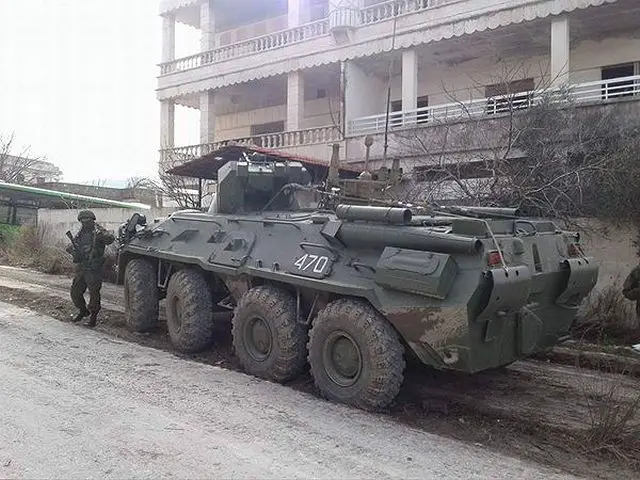- Army
- Conflicts in the world
- Israel - Iran conflict 2025
- Pakistan - India Conflict 2025
- Russia Ukraine War 2022
- Libya conflict day by day
- HAMAS - Israel War 2023
- Operation Serval in Mali French Army
- Sangaris operation Central African Republic
- Sangaris opération militaire République Centreafrique
- Ukraine - Russia conflict
- Syria conflict news
- Defence & Security Industry Technology
- Armies in the world
- Analysis Defense and Security Industry
- Conflicts in the world
- Navy
- Air
Foreign media report deployment of Russian land forces in Syria with tanks and combat vehicles TASS 12701163
|
|
|||
|
The conflict in Syria
|
|||
|
|
|||
| Foreign media report deployment of Russian land forces in Syria with tanks and combat vehicles. | |||
|
In spite of the statements by Russia’s military-political leaders about their lack of plans for ground operations in Syria, the foreign media have been reporting both Russian troops’ active participation in the ground fighting and numerous losses sustained by the Russian Armed Forces in Syria.
|
|||
|
|
|||
 Syrian army soldier on the top of Russian T-90 main battle tank in southern Aleppo. Image courtesy of @2Rook14. Syrian army soldier on the top of Russian T-90 main battle tank in southern Aleppo. Image courtesy of @2Rook14. |
|||
|
|
|||
|
Alexei Ramm writing in his article in the Military Industrial Courier weekly says the Russian Defense Ministry has never denied the presence of elements of the 810th Separate Marine Brigade, reinforced with T-90 tanks. The elements are providing security for Khmeimim air base and, if need be, can conduct combat search and rescue (CSAR) operations in support of downed Russian aircraft, similar to that mounted to rescue the crew of the downed Sukhoi Su-24 (NATO reporting name: Fencer) tactical bomber. Moreover, television broadcasters covered the rotation of elements of the 810th Marine Brigade proactively on December 28, 2015. The photos and videos clearly showed Russian military hardware, including tanks and Tigr and Rys armored vehicles..
As far as the Military Industrial Courier weekly is aware, the first rotation to Syria included 186 Marines from the assault and reconnaissance battalions and sniper company of the Black Sea Fleet’s Marine brigade. According to Lt. Col. Vassily Khomyak, his troops have not only provided security for the air base, but also have covered the ground underlying the flightpaths of the air task force’s aircraft and patrolled the area adjacent to the airfield. Not all of his Marines made it back to Crimea - Marine Alexander Pozynich had been killed in action on the CSAR operation in support of the downed Su-24M. Early reports of Russian Army tanks in Syria cropped up in the foreign media early in September last year, after satellite imagery of Bassel al-Assad International Airport (now Khmeimim air base) had been published. Seven combat vehicles (presumably T-90 tanks) were mentioned then. According to the foreign media, the tanks guarding Khmeimim are from the tank battalion of the 27th Motor-Rifle Brigade stationed in the settlement of Mosrentgen. However, the newspaper believes that the tanks deployed to Syria may well be operated by the 19th or 20th Separate Motor-Rifle Brigades stationed in the North Caucasus or by the 4th Military Base in South Ossetia. The T-90s operated by these units retain the three-color camouflage pattern seen in the pictures and video footage. |
|||
|
|
|||
 Russian air force personnel prepare to load humanitarian cargo on board a Syrian plane at Hemeimeem air base in Syria, Wednesday, Jan. 20, 2016. Russian air force personnel prepare to load humanitarian cargo on board a Syrian plane at Hemeimeem air base in Syria, Wednesday, Jan. 20, 2016. |
|||
|
|
|||
|
In addition, there are servicemen with the 120th Artillery Brigade (Yurga, Kemerovo Region) in Syria. Six Russian 2S19 Msta-B howitzers operated in the vicinity of the village of Hamrat in Homs province.
Mention should be made that the personnel and materiel of Khmeimim air base are protected by not only Marines from the 810th Brigade, but by military police elements as well. In addition to the troops wearing the distinctive red berets, the picture and videos caught a Rys armored car, which came as some surprise, because the military has denied the purchase of the type until recently. According to a Defense Ministry official familiar with the issue, however, the ministry decided to equip specifically MP units with Russian-made Italian-designed vehicles: "The contract for the Rys’s production is still in force. The vehicle is of little use to maneuver units, but its trials showed that it is just the thing for MPs." Another significant aspect of the assistance to the Syrian governmental forces is the so-called military advisors, whose work the Russian military-political leadership has neither admitted, nor denied. It is worth mentioning that Russian military advisors and specialists had worked in Syria long before the civil war. The number of the ‘voluntary assistants’ dropped sharply with the commencement of the hostilities, but they did continue to execute certain tasks. The military advisors and specialists have been more active recently, and their number has grown too. They provide, inter alia, combat training to Syrian officers and newly activated units prior to their departure to the frontline. Interestingly, they have been working so actively and on such a large scale that there have been many pictures on social networks, showing Russians training Syrian troops. Although the Defense Ministry denies the immediate involvement of the Russian advisors in the fighting, one of the videos shows an officer (probably, a full colonel) saying that the Syrian troops he is attached to have never retreated during his tenure there. Judging by the blasts and gunfire heard in the background, the video was shot in battle. The Russian military instructors are handling even more difficult missions - training the governmental troops to operate the Russia-supplied advanced weaponry, in particular T-90 tanks, TOS-1 heavy flamethrowers, BM-30 Smerch and BM-27 Uragan multiple-launch rocket systems, etc., and restoring the Syrian Army’s vehicle recovery and repair capability. The effective job done by the Russian military specialists was highlighted by Russian President Vladimir Putin’s statement during his press conference in December that Russia had rebuilt the Syrian air defense systems. |
|||
|
|
|||
 Russian marines in Salma. 3 Kamaz 5350 (armoured), 1 Ural-4320 and one BTR-82A. (Source https://twitter.com/Ald_Aba) Russian marines in Salma. 3 Kamaz 5350 (armoured), 1 Ural-4320 and one BTR-82A. (Source https://twitter.com/Ald_Aba) |
|||
|
|
|||
|
The pictures of the Syrian Army’s hardware seized by the Islamic State during the counterattack near Deir al-Zor, which have been recently circulated by the terrorists on social networks, show the combat vehicles of the Kvadrat surface-to-air missile (SAM) system (launcher and acquisition and engagement radar) in good running order.
Judging by the videos, part of the Syrian Army’s combat hardware had been damaged, but later was repaired and returned to the frontline. The militants have been ever more often using makeshift combat vehicles converted from up-armored SUVs, trucks and even tractors instead of tanks, armored personnel carriers (APC) and infantry fighting vehicles (IFV). Certainly, the effectiveness of the repaired combat vehicles is arguable, but one has to admit that the Syrian Army’s materiel recovery and repair efforts do produce results, unlike those made by the militants. In addition to the afore-said Russian military units providing security for Khmeimim air base, it is possible that Russian paratroopers as well as scouts and snipers with the several Russian Army brigades operate in Syria. Presumably, they are scouts and snipers from the 7th Air Assault Division (Mountain) of the Airborne Force and 34th Separate Mountain and 74th Separate Motor-Rifle Brigades. The Defense Ministry has neither confirmed, nor denied that troops from the above units have been deployed to Syria. Still, a source of the weekly explained that the snipers and scouts of the 7th Air Assault Division and 34th Separate Motor-Rifle Brigade, skilled in mountain operations, are the best choice for Latakia province characterized by hills and mountains. In addition to the T-90 tanks, advanced BTR-82A APCs have been deployed to Syria too. A video by a Syrian news agency showing a BTR-82A sporting the typical three-color camouflage pattern made headlines last fall. Russian voices were clearly heard in the background of the video. Truth be told, the advanced APCs have not been shot by still or video cameras since then. However, photos of a BTR-82 and Russian troops have appeared on social networks of late. Judging by their geolocation data, the pictures had been taken in Latakia, near the recently liberated town of Salma. The single-color green paintjob indicates that the vehicle had been delivered to the military not long before. |
|||
|
|
|||
 BTR-82A Armoured Personnel Carrier in Sal'ma Latakia (Source http://syria.liveuamap.com) BTR-82A Armoured Personnel Carrier in Sal'ma Latakia (Source http://syria.liveuamap.com) |
|||
|
|
|||
|
The weekly noted that the Russian task force in Syria included Special Forces operators and personnel with the Special Operation Forces Command (SOFC) [the former are Spetsnaz and the latter are from a separate command]. Defense Minister Sergei Shoigu personally briefed President Vladimir Putin on SOFC’s participation in the CSAR operation in support of the Su-24M tactical bomber shot down by the Turkish Air Force. Interestingly, this is the first time since the return of Crimea that our military-political leadership has officially mentioned the activities of the Russian special operations forces.
Judging by the photographs, the SOFC troopers have operated in Syria at least since last September. However, the halo of mystery around the newly formed command prevents the understanding of the missions handled by its troops. Presumably, they not only execute special ‘black’ missions, but also provide close protection for ranking Russian commanders and combat training for Syrian personnel. At the same time, our Special Forces (Spetsnaz) troops with their organic Tigr armored wheeled vehicle were deployed to Syria. Presumably, they are from a composite Special Forces detachment comprising elements of several Spetsnaz brigades. The Spetsnaz servicemen provide security for the Russian military advisors and combat training for Syrian troops. According to the Syrian media, Russian special operators took part in the CSAR operation to retrieve Capt. Konstantin Murakhtin, navigator of the downed Su-24M bomber. The foreign media are actively speculating about the composition of the Russian ground task force in Syria, often citing unnamed sources in their national intelligence services and defense ministries. The Russian Defense Ministry prefers not to mention its ground task force operating in Syria. Judging by the official statements, the Russian participation in the hostilities in Syria boils down to the job being done by the air task force. However, the reports of Russian artillerymen in Homs province, Sergei Shoigu’s report about a successful operation by SOFC and numerous pictures and videos prove otherwise. The weekly concludes that too restrained an information policy leaves room for propagandistic speculations and allegations about heavy losses suffered by Russian troops in Syria and atrocities against local population committed by them, which are not true. Military experts presume that the Russian Defense Ministry does not have to deny that our countrymen are playing a limited - albeit immediate - part in the fighting, provide combat training to the governmental forces and teach them to operate advanced combat vehicles and fix broken and damaged ones. |
|||
|
|
|||
|
© Copyright 2016 TASS. All rights reserved. This material may not be published, broadcast, rewritten or redistributed.
|
|||


























